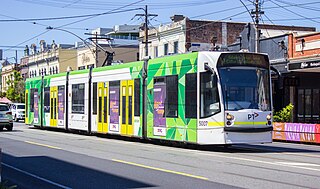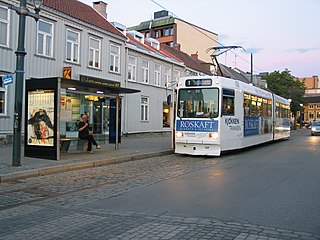
Hong Kong Tramways (HKT) is a 3 ft 6 in narrow-gauge tram system in Hong Kong. Owned and operated by RATP Dev, the tramway runs on Hong Kong Island between Kennedy Town and Shau Kei Wan, with a branch circulating through Happy Valley.

Melbourne tram route 6 is operated by Yarra Trams on the Melbourne tram network from Moreland to Glen Iris. The 19.2-kilometre (11.9 mi) route is operated out of Brunswick and Malvern depots with Z, B and D class trams.

Melbourne tram route 75 is operated by Yarra Trams on the Melbourne tram network from Vermont South to Central Pier. The 22.8 kilometre route is operated out of Camberwell depot with A and B class trams. It is the longest route on the network.

Melbourne tram route 59 is operated by Yarra Trams on the Melbourne tram network from Airport West to Flinders Street station. The 14.7 kilometre route is operated out of Essendon depot with Z and B class trams.

Melbourne tram route 57 is operated by Yarra Trams on the Melbourne tram network from West Maribyrnong to Flinders Street station. The 11.6 kilometre route is operated out of Essendon depot with Z class trams.

Melbourne tram route 16 is a tram route on the Melbourne tramway network serving the city of Melbourne in Victoria, Australia. Operated by Yarra Trams, the route is coloured light yellow and extends from Melbourne University to Kew over 20.2 kilometre of double track via Swanston Street, St Kilda Road, Fitzroy Street, The Esplanade, Balaclava Road and Glenferrie Road. It is serviced out of Malvern depot utilising Z and D1 class trams.

Melbourne tram route 67 is operated by Yarra Trams on the Melbourne tram network from Melbourne University to Carnegie. The 12.7-kilometre (7.9 mi) route is operated out of Glenhuntly depot with Z and B class trams.

The Sydney tramway network served the inner suburbs of Sydney, Australia, from 1879 until 1961. In its heyday, it was the largest in Australia, the second largest in the Commonwealth of Nations, and one of the largest in the world. The network was heavily worked, with about 1,600 cars in service at any one time at its peak during the 1930s . Patronage peaked in 1945 at 405 million passenger journeys. Its maximum street trackage totalled 291 km in 1923.

Melbourne tram route 64 is operated by Yarra Trams on the Melbourne tram network from Melbourne University to East Brighton. The 18.1 kilometre route is operated out of Glenhuntly depot with Z and B class trams.

The Gråkallen Line is an 8.8-kilometre (5.5 mi) suburban tram line located in Trondheim, Norway. As the only remaining part of the Trondheim Tramway, it runs from the city centre at St. Olav's Gate, via the suburban area Byåsen to Lian. It is designated Line 9, and is served by six Class 8 articulated trams. After the closure of the Arkhangelsk tramway in 2004, it became the world's northernmost tramway system.

Boreal Bane AS, trading, and formerly known as, AS Gråkallbanen, is a Norwegian company that operates the remaining part of the Trondheim Tramway, Norway. It operates six trams on the Gråkall Line, that connects the city centre to parts of the suburb of Byåsen, and the recreational area at Lian. It has 800,000 annual passengers, and operates as Line 1. The trams operate each 15 minutes during the day, and each 30 minutes in the evenings and during the weekends.

The Trondheim Tramway in Trondheim, Norway, is the world's most northerly tramway system, following the closure and dismantling of the Arkhangelsk tramways in Russia. It consists of one 8.8-km-long line, the Gråkallen Line, running from St. Olav's Gate in the city centre through Byåsen to Lian Station in Bymarka.

St. Olavs Gate in Trondheim, Norway is the location of the terminal station of Gråkallbanen, the only remaining tramline in Trondheim. The station serves the city center and is located two blocks from the bus station at Munkegata Terminal. It is located on St. Olavs Gate between Kongens Gate and Dronningens Gate.

The Singsaker Line was a branch of the Trondheim Tramway which ran from Øya and Elgeseter to the neighborhoods of Singsaker, parts of Tyholt and Rosenborg in Trondheim, Norway. The line branched off from the Elgeseter Line at the Student Society. It was double track until Tyholtveien, after which it ran through a loop through Rosenborg. It was served by Line 3, which continued through the city center to Trondheim Central Station.

The Elgeseter Line was a tramway line in Trondheim Tramway between Trondheim Torg and Elgeseter. The tram line was built in 1913, expanded in 1923 and abandoned in 1983. It was used by Line 2 operated by Trondheim Sporvei, later Trondheim Trafikkselskap, though part of the line was used by Singsaker Line.

The Lade Line was a tramway between Munkegata and Lade in Trondheim, Norway. The first part of the line was opened in 1901, but not expanded to Lade until 1958. The line was operated by Trondheim Sporvei and Trondheim Trafikkselskap until it was abandoned in 1988.

Reading Corporation Tramways operated a tramway service in Reading in the English county of Berkshire between 1901 and 1939.

The Trondheim Tramway controversy regards the political discussion of whether Trondheim, Norway, should have a tramway.

The Kolkata Tram System, is a tram system that serves Kolkata, the capital city of the Indian state of West Bengal, operated by West Bengal Transport Corporation (WBTC) after Calcutta Tramways Company (CTC) was merged with WBTC. Being started in 1873 Kolkata tram is the oldest operating tram network in the world. Being electrified in 1902, Calcutta became the first Asian City with electric tramway. The Kolkata Tram is the only tram system operating now in India. With the help of periodic negligence, the Government of West Bengal had formed systematic initiatives to suspend the entire tram network from the city and sell properties. However, an apolitical organization named Calcutta Tram Users Association (CTUA) was formed in 2016 to advocate in favor of Kolkata's tram system. The network initially had up to 37 lines in the 1960s, but has gradually reduced over the years with only two lines currently operating due to financial struggles, poor maintenance, low ridership, addition of road flyovers, expansion of the Kolkata Metro, slow tram speed and perceptions that the trams are outdated and occupy too much road space. There are currently two tram routes running which are route 5 and route 25.
The Melbourne tram network began in 1884 with the construction of the Fairfield Horse Tramway. However, the purpose of the line was to increase land prices in the area, and it soon closed during the depression in 1890. The first genuine attempt to construct a tramway network was the construction of the Richmond cable tram line by the Melbourne Tramway & Omnibus Company in 1885. Over the next few years, 16 more cable tram lines were constructed, as well as numerous other horse tramways. The depression of the early 1890s slowed further expansion of the cable network. The first electric tram line was the Box Hill and Doncaster tramway which opened in 1889. This was a pioneering line in what was then the countryside and thus didn't receive much patronage. It closed in 1896. The next attempt at an electric tramway was Victorian Railways' St Kilda to Brighton line, which opened in 1906. Later that year, the North Melbourne Electric Tramway & Lighting Company opened lines to Essendon and Maribyrnong. Many local councils formed their own tramway trusts and built tramways within their own constituency. The most successful of these was the Prahran & Malvern Tramways Trust.

















